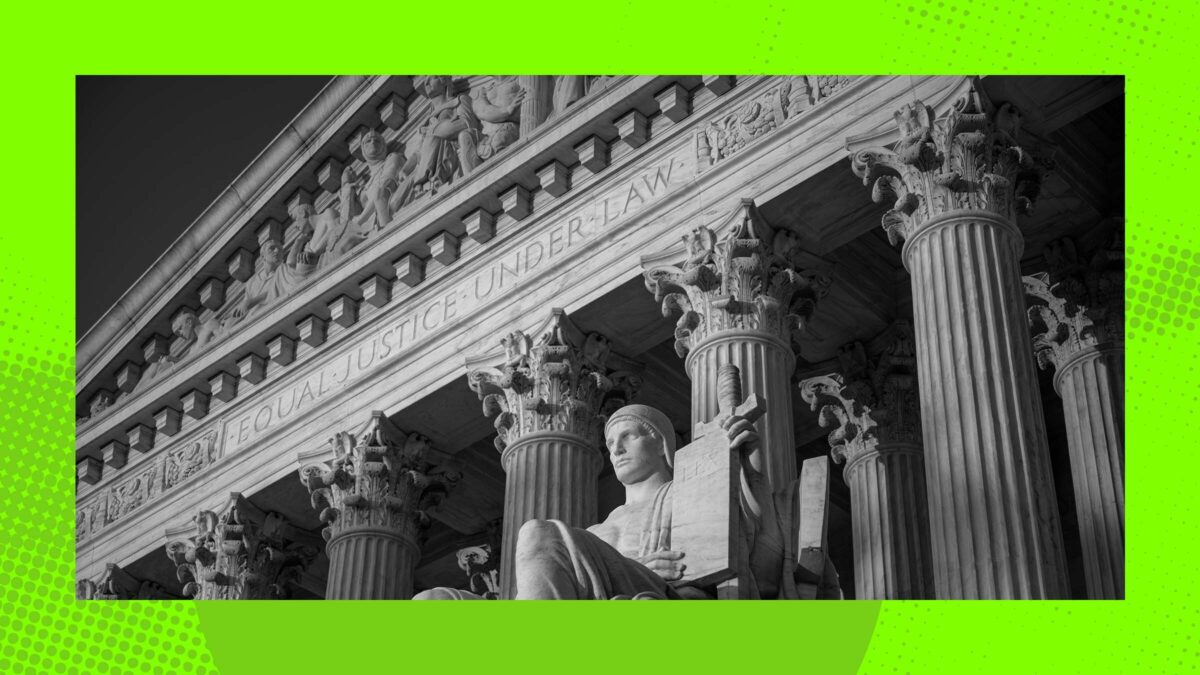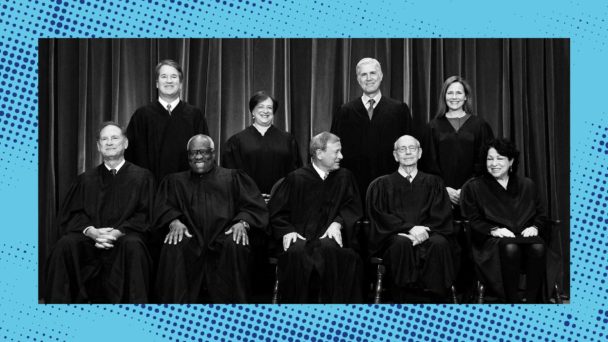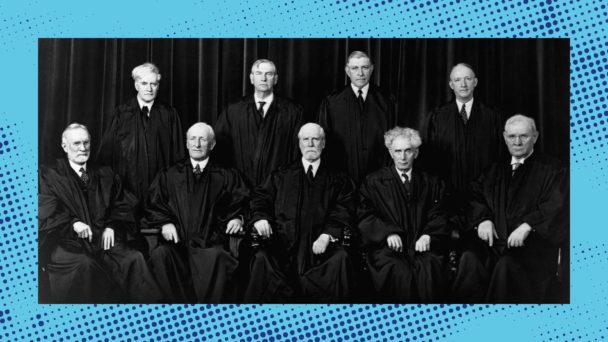American democracy is held together by scotch tape, sheer force of public will, and, occasionally, levers of government like the courts. Many Republican officials have a problem with this: They think a political system where they can’t win elections legitimately isn’t a system worth having at all. One democracy-destabilizing strategy recently advanced by the conservative legal movement is a novel reading of the Constitution—the so-called “independent state legislature theory”—that would have given state legislatures unbridled power to manipulate elections without oversight from the courts or even their own state constitutions.
Yet in another surprise victory for those of us who believe in a multiracial democracy, the Supreme Court issued a decision on Tuesday that rejected this shameless ploy to upend elections nationwide. The Court’s 6-3 ruling in Moore v. Harper recognizes that state legislatures do have the power under the Elections Clause to prescribe the time, place, and manner of federal elections, as articulated in the Constitution’s Elections Clause. But this isn’t Mean Girls—limits do indeed exist, and state courts can review state legislatures’ election regulations, including redistricting maps and voting restrictions, for compliance with state law.
As in Allen v. Milligan, which reaffirmed that racial gerrymandering is illegal, Chief Justice John Roberts authored a majority opinion upholding another basic principle of law: Yes, state constitutions do, in fact, apply to state legislatures. Or as Roberts put it, the Constitution “does not insulate state legislatures from the ordinary exercise of state judicial review.” This could’ve been pulled from Schoolhouse Rock, because it’s as basic a proposition as it can get. Ruling any differently would have been outright disastrous for free and fair elections. I’ve said this before, but we cannot be satisfied by decisions offering mere crumbs of democracy to a starving nation. Far from a voting rights hero, Roberts writes in a way that doesn’t so much showcase a love of democracy as evidences his hatred of sloppiness, and his fellow Republicans did some damn sloppy work here. (More on this in a bit.)
Further, while Moore v. Harper provides much-needed clarity on what state legislatures cannot get away with when they attempt to regulate elections as we approach 2024, it raises some new questions about the power of the Supreme Court to regulate everyone else. If liberals and conservatives agree on anything, it’s that they love them some judicial supremacy, which may explain why Moore was bipartisan—with the three liberal justices plus Brett Kavanaugh and Amy Coney Barrett joining Roberts.
But first, let’s step back a bit. Moore v. Harper took a scenic route to the United States Supreme Court by way of the Supreme Court of North Carolina, which until not too long ago Democrats controlled. The North Carolina General Assembly had to redraw its electoral district map following the 2020 Census to account for the state’s significant population growth in the preceding ten years, and several groups sued in state court to block the new map as an impermissible gerrymander. The state’s trial court found that the map was “intentionally and carefully designed to maximize Republican advantage in North Carolina’s Congressional delegation,” but it thought partisan gerrymandering is a political question that can’t be resolved by courts. The state supreme court disagreed at first and struck the map down, recognizing that the North Carolina legislature was electorally punishing people because of their political affiliation, in violation of the state constitution’s guarantee that “all elections shall be free” as well as its provisions on equal protection, free speech, and free assembly. North Carolina lawmakers appealed to the Supreme Court and argued that the Constitution gives state legislatures exclusive and independent authority over how elections are run, so state courts and constitutions, like their own, have no authority to provide any meaningful checks and balances.
This is the heart of the independent state legislature theory, and although its defenders dressed it up with a legitimate sounding name, it is patently absurd if you think about it for more than five seconds.
Just as the United State Congress is created and bound by the United States Constitution, state legislatures are created and bound by state constitutions. Nowhere in the federal Constitution, court precedents, or history is there any evidence of an election regulation carveout to this general principle. And with good reason: State legislatures would otherwise be able to violate their state constitutions willy-nilly and suppress people’s votes out of existence without any state oversight or recourse. They could go even further in establishing extreme gerrymanders, removing voter protections, and giving themselves a role in calculating election results–the world would be their antidemocratic oyster. They might even provide vaguely legal-sounding justifications for overturning an election.
The lived experiences of people of color and the professional experiences of democracy and race scholars provide stark warnings about what happens when states are permitted to govern elections with impunity. Checks and balances have been insufficient but nevertheless important in preventing the continued disenfranchisement of marginalized people and staving off the entrenchment of white minority rule. By removing those checks, the state supremacist scheme would make people of color especially vulnerable. Troublingly, the Supreme Court already said in Rucho v. Common Cause (2019) that partisan gerrymandering claims present political questions beyond the reach of federal courts, and the Court insulated many state regulations of the time, place, and manner of elections from federal review under the Voting Rights Act in Brnovich v. Democratic National Committee (2021). State courts are one of the last remaining avenues functionally open to redress election discrimination and other mischief under existing law. And Republicans sought to block that path in Moore v. Harper.

(Photo by Evelyn Hockstein/For The Washington Post via Getty Images)
After the Supreme Court agreed to hear the North Carolina case but before it made its decision, the state’s supreme court pulled a bait and switch. A change in the state court’s composition after the 2022 elections flipped the court back to Republicans, who were happy to go back on the prior majority’s very recent word and now say that partisan gerrymandering claims aren’t justiciable under the state’s constitution after all. While that decision, issued in April, seems to preserve a role for state courts generally in reviewing the legality of actions taken by state legislatures, it renders the North Carolina constitution functionally toothless against partisan gerrymandering and strips millions of voters of their fundamental right to govern themselves. Democratic-appointed Justice Anita Earls’ dissent castigated the Republican majority for “its shameful manipulation of fundamental principles of our democracy and the rule of law” in order to confer advantage to other Republicans.
I recount all this procedural mess because Moore v. Harper did not disturb the now Republican-dominated North Carolina Supreme Court’s finding that partisan gerrymandering is not justiciable. Roberts did, however, put the most extreme version of the state supremacist scheme to rest. State legislatures are obviously constrained by state constitutions, including in how they run elections. Getting the Supreme Court’s blessing to do otherwise would have been nothing short of a judicial insurrection, allowing conservatives to do with black robes and gavels what they failed to do with MAGA hats and zipties. Curiously, the Supreme Court did not attempt to spell out these clear boundaries for state legislatures, and instead created much more nebulous boundaries for state courts to follow.
Here’s where Roberts tries to tell everyone who’s in charge. He acknowledges that state courts still must abide by federal law and says twice that state courts may not exceed “the ordinary bounds of judicial review.” What are the ordinary bounds of judicial review, you ask? Beats me. It’s not clear from the opinion what kinds of state interpretations of state law are so far out of bounds as to implicate the Elections Clause. Whatever they are, they may give state legislatures the opportunity to ask the federal courts for a do-over if they don’t like the decision they received in state court—sort of like if you already got a final answer from Mom but you didn’t like that answer, so you go ask Dad. And also your dad doesn’t think people of color should be able to vote. Also your dad is Clarence Thomas.
We saw a version of this in 2020, when Pennsylvania Republicans ran to the Supreme Court because they didn’t like how the state supreme court had extended the deadline for receipt of mail-in ballots due to the pandemic. Samuel Alito, the Court’s resident king fisherman and harborer of petty grievances, threw a fit—and began toying with the idea that the independent state legislature theory might be a thing. So this same song and dance is bound to repeat itself in 2024. With the question of when federal courts can step in delayed for another day, the Supreme Court may yet round out its current term with our fragile democracy more or less in the same condition as when the year started. No one should understand that to mean that the condition of our democracy is good. As professor and election law expert Rick Hasen writes, “the goal posts have moved so much that keeping the status quo looks like a victory.” But folks aren’t cheering because the Supreme Court made things better. All the Court did is decline this particular invitation to make things worse.




